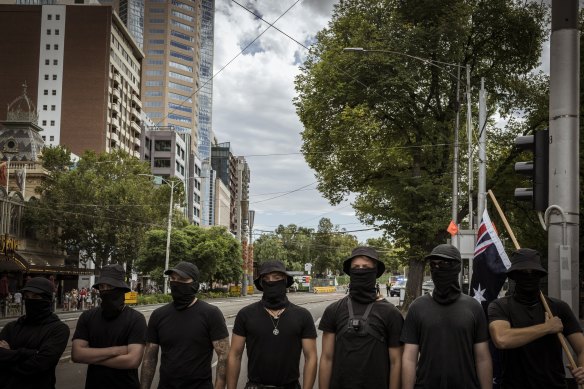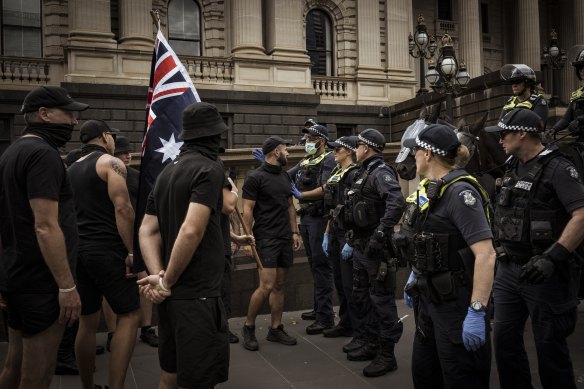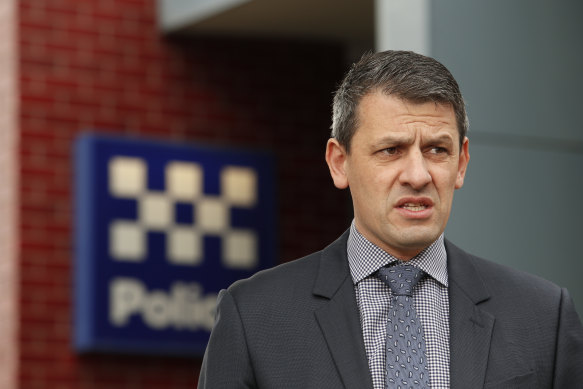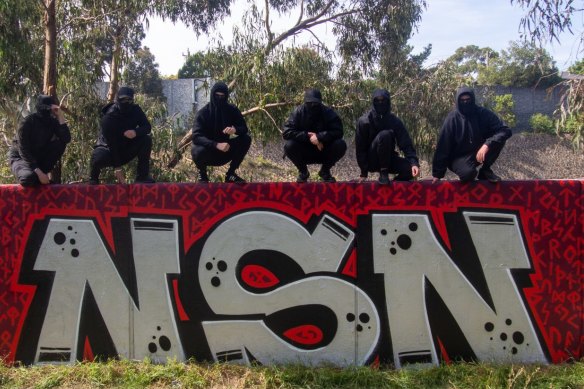Why it’s so hard to stop neo-Nazi public hate parades
By Simone Fox Koob
The state government is combating a small, toxic group of neo-Nazis in Victoria.Credit: Chris Hopkins
Save articles for later
Add articles to your saved list and come back to them any time.
It was a momentary movement, done casually and with a laugh, but caught on camera by a media scrum.
Following a combative back-and-forth with journalists after being sentenced for assault, Jacob Hersant, one of two neo-Nazi leaders leaving Melbourne’s County Court in October said “Heil Hitler” and raised a straight arm.
Walking away, he quipped: “Nearly did it. It’s illegal now, isn’t it?”
The action has set off a chain of events which will be intensely watched by the state government, police, lawyers, MPs and the country’s neo-Nazis.
Police charged Hersant on Friday under laws that came into force only a week before the action outside court. The ban on the Nazi salute was introduced after a group of black-clad men made the gesture outside Melbourne’s Parliament House in March.
That followed a ban on the Nazi swastika, as the government combats a small, toxic group of neo-Nazis in Victoria.
Community condemnation of their public acts has been swift and strong, while the new Victorian laws enjoy bipartisan support and strong backing from Jewish groups.
There are critics, though, of this legislative approach, who claim it’s ineffective, potentially counterproductive, and will do little to curb the increasingly brazen activities of the groups. Authorities also remain concerned about the risk of far-right terrorism — is it getting worse?
‘Looking to bring attention’
In the past year, neo-Nazis have performed salutes on busy streets, outside council buildings and at restaurants and pubs, as well as the infamous parliament protest. They have intimidated people in public, gatecrashed rallies being held on everything from immigration, drag story time and trans rights, and spread antisemitic and racist messages through old-school propaganda campaigns including posters and stickers.
Two weeks ago, a group dressed in black marched through Flinders Street station and boarded a train in the middle of the night, saluting and singing about White Australia in front of shocked passengers. Police originally said no offences were detected, but have since said the incident was still under investigation.
Other activity has been more behind the scenes. An investigation by The Age last year uncovered links between Legacy Boxing Gym, in Sunshine West, some of Victoria’s most dangerous neo-Nazi activists, and a growing community of young men learning to box at the gym. Brimbank Council is investigating the gym with the help of Victoria Police.
These are activities closely watched by the police, who say far-right terrorism is a serious and growing concern. Recently, ASIO chief Mike Burgess was asked about the expected reaction by the neo-Nazis to the ongoing conflict in the Middle East. While not expecting them to plan acts of violence, he said the groups would likely exploit the conflict to promote their cause.
“They are looking to bring attention to it and recruit more members,” he said.
It’s this ramping up of propaganda that concerns experts, researchers and police, given the propensity for lone far-rights actors to quickly become radicalised and carry out violence.
Anti-fascist researchers at the White Rose Society believe the National Socialist Network has become bolder on Melbourne’s streets in the past year, developing a militant and visible street presence to attract recruits and appear threatening to the general population.
“From this, they can create propaganda for a local as well as international far-right audience. This is achieved not just through actions, but visible street propaganda like misogynistic and violently racist stickering,” the researchers say.
Dr Kaz Ross, who researches far-right extremism and conspiracy groups, says that unfortunately, they have been successful in attracting attention.
“Part of that is the political landscape. They have successfully latched onto various issues and used them to recruit and wedge,” she says. “They themselves say, people are used to seeing us around now, and unfortunately, I think that’s right.”
Recent messages shared by the NSN and other right-wing channels on social media seen by The Age show the neo-Nazis celebrating the rejection of an Indigenous Voice to parliament, framing it as a victory for white Australia. They are now targeting the treaty processes being undertaken by individual states. The war in the Middle East is also used to promote antisemitism and Islamophobia, particularly fearmongering about Muslim migration to countries in the west.
“Ultimately, the thing is immigration,” says Ross. “The end goal is to change discourse. They are not a mass organisation … I don’t think the end goal is recruitment, it’s to change the political discourse in Australia.”
Experts liken much of their recent activity to performance art, stunts that they can film for circulation on social media and which they know will get media attention.
In its 2023 report on trends in antisemitism, one of the main things noted by the Executive Council of Australian Jewry was the increase in neo-Nazi antisemitic propaganda in the form of posters, stickers, particularly in eastern states and South Australia. The council recorded a 70 per cent increase in reports of this kind of antisemitic material.
“For now, these neo-Nazis are promoting their racist ideology, producing hate propaganda material, recruiting new members, and engaging in legal activities aimed at bonding and planning, and solidifying the efficacy of their organisations,” council researcher Julie Nathan wrote. “It would be wrong to dismiss them as a tiny lunatic fringe of racists.“
The Australian Federal Police also say that while the groups transition between online and offline engagement, using hate symbols and historical symbology as a key tool to attract attention and rally individuals, investigators are also aware of an increase in physical demonstrations.
These stunts also present issues for the media. How much exposure should be given to a relatively small group, while still countering the harmful antisemitic sentiment they are trying to spread?
When given the opportunity several weeks ago to comment on their sentencing for assault, Thomas Sewell and Hersant began by reciting white supremacist phrases before expressing their innocence, saying there were two sides to the story and claiming they had been targeted because they were “political dissidents.” The media did not broadcast or publish the majority of their comments.
University of Canberra’s Dr Jordan McSwiney, who researches the far right, acknowledges that it’s a difficult line for the media to walk.
“What does responsible harm-reduction coverage look like? You can’t not cover [neo-Nazis saluting on the steps of parliament] because it is newsworthy. It is important that the people in the community are aware that there are Nazis in their midst. That’s something they need to know about so they can get rid of them. The difficult thing is how to report in a way that doesn’t give neo-Nazis the legitimation that they’re seeking. I don’t think there’s like a silver bullet for this,” he says.
“The best way to fix this problem isn’t to not report on it, but for newsrooms to actually invest in dedicated training and upskilling, particularly for junior reporters, about how to do this and how to do it responsibly. And acknowledging that responsibility.”
He said things like uncritically quoting neo-Nazis in an attempt to provide “balance” was a common mistake that could be easily rectified. Media could also decide to avoid republishing propaganda created by the groups, such as videos, pictures or memes of their stunts.
“It’s really important to have people who have been working this beat for a long time, who are able to actually contextualise some of the players and their claims. They can identify what is clearly a propaganda stunt and report on it in a way that is more sensitive.”
Some of the highest-profile incidents have happened in Victoria, but experts have a mixed response when asked if the state has a particular problem.
Some believe that Melbourne’s very political, strong anti-fascist movement, can generate a strong opposition.
Also, the main leaders of the movement are in Victoria. Hersant went to University High School, and Sewell moved to Australia from New Zealand as a young child, finishing his VCE at Balwyn High School.
Both men have young children. Their chapters of the National Socialist Network and European Australia Movement are the most visible on the street because of their culture of street activism, says the White Rose Society.
“They need to be seen to be leading the way with bold actions,” it says.
The researchers also note that Adelaide is the city where neo-Nazis have been charged with much more serious offences, including planning terrorist attacks and possessing extremist material. In Queensland this year, police launched an inquiry into connections between two serving officers and alleged white supremacists.
‘Tell us what our job is’
Jacob Hersant was charged on Friday, the court proceedings will be closely watched, and not just in Victoria’s legal circles.
The newly introduced Victorian legislation defines the Nazi gesture as a Nazi salute, any other gesture used by the Nazi Party, or, crucially, a gesture that “so nearly resembles a gesture … or that is likely to be confused with or mistaken for” the Nazi salute.
It is not the only test case in Australia. In Sydney, two court cases are under way — one involving several fans at a soccer match, and another where three men were charged over alleged saluting outside the Sydney Jewish Museum. They were all charged with knowingly displaying a Nazi symbol without excuse.
Members of a neo-Nazi group square off against police at an anti-trans rights rally outside Victoria’s parliament in March.Credit: Chris Hopkins
Meanwhile, in Victoria, authorities are grappling with how neo-Nazi rallies and public stunts are policed.
Victoria Police faced sustained criticism about a perceived lack of response to public demonstrations and incidents involving neo-Nazis, with groups like the White Rose Society concerned the neo-Nazi groups would be encouraged to go further in their stunts without legal consequences.
In recent weeks, Jewish groups have also accused the police of double standards for not cracking down on perceived antisemitic content at political rallies.
Police have strongly denied this. They have said that in many incidents, what they had witnessed did not fit the requisite elements to pursue charges, including under the Racial and Religious Tolerance Act.
Police union head Wayne Gatt said police were in a bind.
He believes overly narrow legislation such as the ban on the Nazi salute will mean they are constantly playing catch-up, as extremist groups change the way they seek to intimidate and offend others in the community. On the other hand, he also argues that the Racial and Religious Tolerance Act is too broad and complex to enforce on the ground.
Police Association of Victoria chief Wayne Gatt wants more clarity from the government.Credit: Paul Rovere
He wants more clarity and direction from government, particularly when it comes to political protests.
“What is the community’s expectation of its police? There’s a whole range of things that police have to consider and try to do. There are some expectations that are reasonable … and there are some that are simply not. And so the first step is, well, what is our job? What does the government say they want our job to be?” he said.
“You tell us what our job is … There’s a difference between causing offence and stopping a criminal offence. This is what the government has to grapple with. They have to make it clear.”
Gatt said there was the potential for neo-Nazi groups to be influenced when there is little intervention by police.
“I think it emboldens some of these groups. Some of them looking to grandstand … looking to cause a stir. Narrowly constructed legislation doesn’t necessarily mean for seamless execution. And that’s the challenge police have in the operational world,” he said.
Victoria Police wouldn’t comment specifically on the activities of far-right groups, except to say that they closely monitored a range of them to ensure there was no threat to public safety.
A spokesman said that responding to protests was officers’ daily responsibility and police would act on any group that demonstrated support for violence.
“Victoria Police is committed to responding to any acts of racism, discrimination or vilification based on religion, culture or ethnicity,” the spokesman said.
Deputy Commissioner Neil Paterson recently told reporters that while Nazi salutes had been seen at several events in the city, it was difficult for police to manage these acts in an often heated protest environment.
“Our main aim at a protest is to make sure that there are no breaches of the peace that are committed and keeping often parties that oppose each other’s views separate from each other and keeping everyone safe,” he said.
Paterson also said that the Racial and Religious Tolerance Act was complex, and police often needed to seek legal advice before pursuing offences under the act.
A number of briefs have been put before the Director of Prosecutions, he noted, including an incident where young men did the Nazi salute, but the DPP determined there was insufficient evidence to prosecute.
The state government is considering reforms to strengthen anti-vilification laws, with the third and final stage of public consultation recently closed and targeted consultations scheduled for early next year.
A spokesman said they were working with affected communities on how to strengthen the laws, which may include extending the list of attributes that are protected.
‘Criminal law isn’t an effective driver of change’
In March, disturbing scenes of black-clad men gatecrashing an anti-trans rally and doing salutes on the steps of parliament unfolded on a cloudy Melbourne Saturday.
By the Monday, the state government had announced it would ban Nazi gestures by expanding legislation that had previously just prohibited the public display of the Nazi swastika.
It was a speedy response from government, a display to show they were reacting quickly and an attempt to reiterate its message that Victoria was a multicultural, tolerant liberal democracy. It passed through parliament with bipartisan support.
Jewish groups and Holocaust survivors also backed the ban, including the Jewish Community Council of Victoria, Melbourne Holocaust Museum and the Anti-Defamation Commission, whose leader Dvir Abramovich has been campaigning on the issue for many years.
Members of the Australian neo-Nazi group National Socialist Network hiking in the Grampians.
But questions remain about how effective it will be in tackling the problem that it intends to address. Researchers of the far right interviewed by The Age said while the legislation sent the right message — that the community would not tolerate this kind of hate — all believed the bans would do very little to change the operation of neo-Nazi groups, who they believed would find and co-opt other symbols and gestures to use.
Liberty Victoria, while deeply opposed to fascism and far-right extremism, opposed the changes to the legislation, voicing concerns that the laws were ineffective and could be counterproductive.
“We can understand the motivation to stop these symbols and gestures being displayed. We follow that the problem, though, is that the criminal law isn’t an effective driver of change,” said the organisation’s president Mike Stanton.
“Far-right actors are social media savvy and use whatever they can to boost their profile. These kinds of laws give them what they want in some respects, because they will push the boundaries.”
Stanton says the laws are too broad, and carry too much ambiguity for both citizens and those enforcing the legislation. If an offence carries a serious criminal sanction, such as jail time, people should have certainty about what they are and are not allowed to do, he says.
“We do have sympathy for those people who are expected to enforce it because they are not given a list. How are the police supposed to enforce a ban on any symbol ever used by the Nazi Party, or something that so closely resembles that symbol that could be confused with it?”
A Victorian government spokesperson said the ban was more than just legislating against the behaviour — it was sending a message to the community that Nazi ideology had no place in the state, “empowering more Victorians to call it out”, and was one of a number of reforms aimed at strengthening anti-vilification laws.
Know more? Contact the reporter securely at [email protected] or [email protected]
The Morning Edition newsletter is our guide to the day’s most important and interesting stories, analysis and insights. Sign up here.
Most Viewed in Politics
Source: Read Full Article



